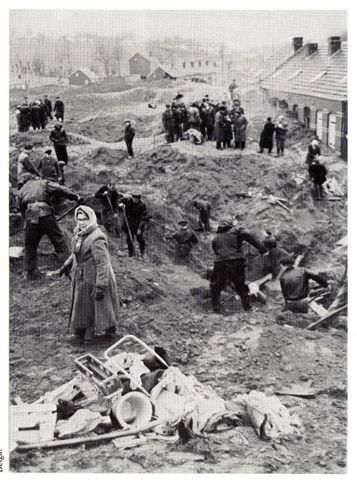19 February 2014
Jupille 1961: an extraordinary fly ash landslide
Posted by Dave Petley
The Jupille fly ash landslide of 1961
The Jupille fly ash landslide is a little-known but quite extraordinary mine waste disaster. It occurred in the town of Jupille in Belgium on 3rd February 1961, killing 11 people, consisting of seven children and four women. The landslide originated from a dump of fly ash that was about 29 m high and covered an area of 4 hectares; the disaster was caused by a collapse of about 550,000 tonnes of the fly ash deposit. The remarkable aspect of the landslide though is the rate of movement – the slide traveled about 700 m in about 60 seconds, despite moving down a very low angled slope (about 3 degrees). The landslide impacted the town at the foot of the valley, burying several houses. There is an account of the landslide here, from which this image of the aftermath is taken:

http://obelix-mbm.skynetblogs.be/archive/2009/08/22/un-vendredi-noir-a-jupille-le-3-fevrier-1961.html
..
This short but desperately sad video shows the aftermath of the landslide and the attempts to rescue the victims. At the end it includes a shot of the slope down which the landslide flowed:
..
The mechanics of the Jupille fly ash landslide
Since the disaster there has been a great deal of interest in the mechanics of the landslide, and in particular its exceptional mobility. Whilst the initial failure is quite easy to explain (little more than a rising water table), the high rate of flow requires a more nuanced explanation. It is certainly true that the landslide was unusually mobile. Investigations at the time suggested that the base of the landslide was not water saturated, which led to the suggestion by Calembert and Dantinne (1964) that the flow was caused by air fluidization. In a nutshell the idea is that the particles of ash became suspended in air, allowing the mass to flow like a liquid with very low viscosity. You can get an idea of the process by watching a video of a pyroclastic flow (though remember that pyroclastic flows are very hot, which was not the case here):
..
However, whilst air fluidization this is widely agreed to be a key mechanism is pyroclastic flows, more recent work has rejected it as a process occurring within landslides. This has been in part because exceptional mobility is also observed in landslides in which air fluidization is unlikely to be important, and in part because it has been believed that entrapping sufficient air within the mass is unlikely. But, the Jupille fly ash landslide is essentially unique, so it has been worth revisiting it with modern analytical techniques. In a paper that is online for the journal Geomorphology, Stilmant et al. (2014) have reanalysed the Jupille fly ash landslide using a new numerical model. This model, combined with field observations of the landslide and its constituent materials, suggest that most likely mechanism was indeed air fluidization. Thus, the landslide started with an initial collapse of the spoil heap, which then caused diffusion of the pressurized air through the mass, allowing it to flow at high velocity. This mechanism can explain the observed morphological features of the landslide and the high degree of observed mobility.
Like many others I suspect I had assumed that the air fluidization theory for landslide mobility had been debunked. It is fascinating to see a case in which this may well be the mechanism that explains the observed behaviour.
References
Calembert, L. and Dantinne R. 1964. L’avalanche de cendres volantes survenue à Jupille (Liège) le 3 février 1961. In: Spronck, R. (Ed.), Amici et Alumni – Hommage à Ferdinand Campus, Georges Thone, Liège, Belgium (1964), pp.41-57.
Stilmant, F., Pirotton, M., Archambeau, P., Erpicum, S. and Dewals, B. 2014. Can the collapse of a fly ash heap develop into an air-fluidized flow? – Reanalysis of the Jupille accident (1961). Geomorphology: http://dx.doi.org/10.1016/j.geomorph.2014.01.020


 Dave Petley is the Vice-Chancellor of the University of Hull in the United Kingdom. His blog provides commentary and analysis of landslide events occurring worldwide, including the landslides themselves, latest research, and conferences and meetings.
Dave Petley is the Vice-Chancellor of the University of Hull in the United Kingdom. His blog provides commentary and analysis of landslide events occurring worldwide, including the landslides themselves, latest research, and conferences and meetings.